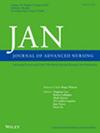Nurse and Other Healthcare Managers' Experiences and Recommendations for Patient Incident Reporting Processes and Real-Time Software Development: A Qualitative Study.
IF 3.4
3区 医学
Q1 NURSING
引用次数: 0
Abstract
AIMS To (1) analyse managers' experiences with handling patient safety incident reports in an incident reporting software, identifying key challenges; (2) analyse the incident report processes from the managers' perspective; (3) examine managers' perceptions of ways to support and improve health professionals' experiences of report-handling processes; and (4) investigate how, from their point of view, incident reporting software should be developed in the future. DESIGN A descriptive qualitative study. METHODS Interviews and focus group discussions on Microsoft Teams from 11/2024 to 3/2025, including 16 participants, analysis with deductive and inductive content analysis. RESULTS Of 16 participants, 15 were managers and one was a patient safety expert. Most were nurse managers (n = 9). Four discussion themes were divided into 30 categories. Participants highlighted the need to improve the reporting software's terminology, classification and analysis tools. The use of artificial intelligence was desired but not currently integrated into the software. Participants were unsure of their skills to use all the software features. Clear and transparent handling processes, feedback, managers' behaviour and communication methods were seen as key to improving staff's experience with report processes. A real-time warning system was considered beneficial for various incident types. Specific questions must be answered before further developing such systems. CONCLUSION This study deepened the understanding of reporting software's challenges regarding its handling features. The handling processes of incident reports had multiple shortcomings, which may negatively affect health professionals' experiences in report handling. Real-time warning systems could assist healthcare managers in processing reports. IMPLICATIONS FOR THE PROFESSION AND/OR PATIENT CARE Organisational-level guidance for incident report processing is needed. Improvements to report processing and reporting software can improve shared learning and understanding of the status of patient safety. PATIENT OR PUBLIC CONTRIBUTION No patient or public contribution. REPORTING METHOD COnsolidated criteria for REporting Qualitative research Checklist.护士和其他医疗管理人员对患者事件报告流程和实时软件开发的经验和建议:一项定性研究。
目的(1)分析管理人员在事件报告软件中处理患者安全事件报告的经验,找出主要挑战;(2)从管理者的角度分析事件报告流程;(3)考察管理者对支持和改善卫生专业人员报告处理流程体验的方式的看法;(4)调查从他们的角度来看,未来应该如何开发事件报告软件。设计:描述性定性研究。方法于2024年11月至2025年3月对16名微软团队成员进行访谈和焦点小组讨论,采用演绎和归纳内容分析方法进行分析。结果16名参与者中,管理人员15名,患者安全专家1名。多数为护理管理人员(n = 9)。四个讨论主题分为30个类别。与会者强调有必要改进报告软件的术语、分类和分析工具。使用人工智能是需要的,但目前还没有集成到软件中。参与者不确定自己是否具备使用所有软件功能的技能。清晰和透明的处理程序、反馈、管理人员的行为和沟通方法被视为改善员工报告程序体验的关键。实时预警系统被认为对不同类型的事故是有益的。在进一步发展这种系统之前,必须回答一些具体问题。结论本研究加深了对报告软件在处理特性方面的挑战的理解。事件报告的处理过程有许多缺点,这可能对卫生专业人员处理报告的经验产生负面影响。实时警报系统可以帮助医疗保健管理人员处理报告。对专业和/或患者护理的影响需要组织层面的事故报告处理指导。对报告处理和报告软件的改进可以改善对患者安全状况的共同学习和理解。病人或公众捐款:没有病人或公众捐款。报告方法定性研究综合报告标准清单。
本文章由计算机程序翻译,如有差异,请以英文原文为准。
求助全文
约1分钟内获得全文
求助全文
来源期刊
CiteScore
6.40
自引率
7.90%
发文量
369
审稿时长
3 months
期刊介绍:
The Journal of Advanced Nursing (JAN) contributes to the advancement of evidence-based nursing, midwifery and healthcare by disseminating high quality research and scholarship of contemporary relevance and with potential to advance knowledge for practice, education, management or policy.
All JAN papers are required to have a sound scientific, evidential, theoretical or philosophical base and to be critical, questioning and scholarly in approach. As an international journal, JAN promotes diversity of research and scholarship in terms of culture, paradigm and healthcare context. For JAN’s worldwide readership, authors are expected to make clear the wider international relevance of their work and to demonstrate sensitivity to cultural considerations and differences.

 求助内容:
求助内容: 应助结果提醒方式:
应助结果提醒方式:


